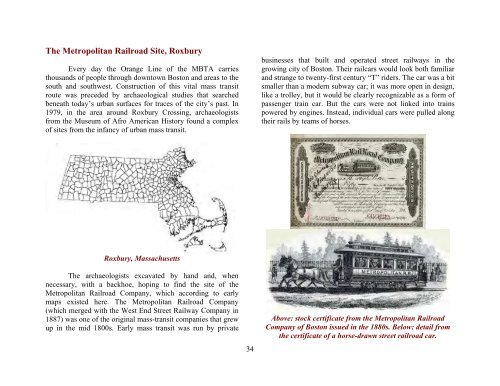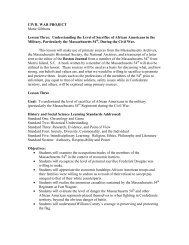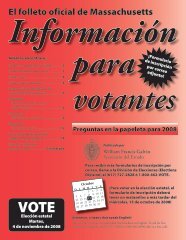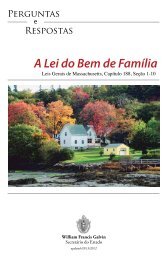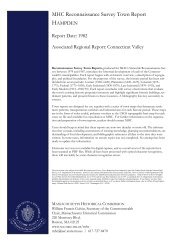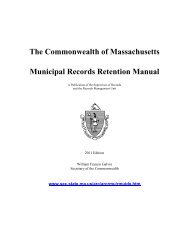Roads, Rails, and Trails - Secretary of the Commonwealth
Roads, Rails, and Trails - Secretary of the Commonwealth
Roads, Rails, and Trails - Secretary of the Commonwealth
You also want an ePaper? Increase the reach of your titles
YUMPU automatically turns print PDFs into web optimized ePapers that Google loves.
The Metropolitan Railroad Site, Roxbury<br />
Every day <strong>the</strong> Orange Line <strong>of</strong> <strong>the</strong> MBTA carries<br />
thous<strong>and</strong>s <strong>of</strong> people through downtown Boston <strong>and</strong> areas to <strong>the</strong><br />
south <strong>and</strong> southwest. Construction <strong>of</strong> this vital mass transit<br />
route was preceded by archaeological studies that searched<br />
beneath today’s urban surfaces for traces <strong>of</strong> <strong>the</strong> city’s past. In<br />
1979, in <strong>the</strong> area around Roxbury Crossing, archaeologists<br />
from <strong>the</strong> Museum <strong>of</strong> Afro American History found a complex<br />
<strong>of</strong> sites from <strong>the</strong> infancy <strong>of</strong> urban mass transit.<br />
Roxbury, Massachusetts<br />
The archaeologists excavated by h<strong>and</strong> <strong>and</strong>, when<br />
necessary, with a backhoe, hoping to find <strong>the</strong> site <strong>of</strong> <strong>the</strong><br />
Metropolitan Railroad Company, which according to early<br />
maps existed here. The Metropolitan Railroad Company<br />
(which merged with <strong>the</strong> West End Street Railway Company in<br />
1887) was one <strong>of</strong> <strong>the</strong> original mass-transit companies that grew<br />
up in <strong>the</strong> mid 1800s. Early mass transit was run by private<br />
34<br />
businesses that built <strong>and</strong> operated street railways in <strong>the</strong><br />
growing city <strong>of</strong> Boston. Their railcars would look both familiar<br />
<strong>and</strong> strange to twenty-first century “T” riders. The car was a bit<br />
smaller than a modern subway car; it was more open in design,<br />
like a trolley, but it would be clearly recognizable as a form <strong>of</strong><br />
passenger train car. But <strong>the</strong> cars were not linked into trains<br />
powered by engines. Instead, individual cars were pulled along<br />
<strong>the</strong>ir rails by teams <strong>of</strong> horses.<br />
Above: stock certificate from <strong>the</strong> Metropolitan Railroad<br />
Company <strong>of</strong> Boston issued in <strong>the</strong> 1880s. Below: detail from<br />
<strong>the</strong> certificate <strong>of</strong> a horse-drawn street railroad car.


